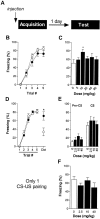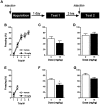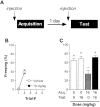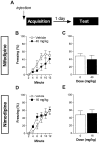L-type voltage-gated calcium channels are required for extinction, but not for acquisition or expression, of conditional fear in mice
- PMID: 12388619
- PMCID: PMC6757698
- DOI: 10.1523/JNEUROSCI.22-20-09113.2002
L-type voltage-gated calcium channels are required for extinction, but not for acquisition or expression, of conditional fear in mice
Abstract
It has been shown recently that extinction of conditional fear does not depend acutely on NMDA-type glutamate receptors, although other evidence has led to the hypothesis that L-type voltage-gated calcium channels (LVGCCs) play a role in conditional fear. We therefore tested the role of LVGCCs in the acquisition, expression, and extinction of conditional fear of cue and context in mice. Using systemic injections of two LVGCC inhibitors, nifedipine and nimodipine, which both effectively cross the blood-brain barrier, we show that LVGCCs are essential for the extinction, but not for the acquisition or expression, of conditional fear in mice.
Figures









Similar articles
-
Like extinction, latent inhibition of conditioned fear in mice is blocked by systemic inhibition of L-type voltage-gated calcium channels.Learn Mem. 2004 Sep-Oct;11(5):536-9. doi: 10.1101/lm.78304. Learn Mem. 2004. PMID: 15466304
-
L-type voltage-gated calcium channels in conditioned fear: a genetic and pharmacological analysis.Learn Mem. 2008 Apr 25;15(5):326-34. doi: 10.1101/lm.893808. Print 2008 May. Learn Mem. 2008. PMID: 18441291 Free PMC article.
-
The L-Type voltage-gated calcium channel Cav1.3 mediates consolidation, but not extinction, of contextually conditioned fear in mice.Learn Mem. 2006 Sep-Oct;13(5):584-9. doi: 10.1101/lm.279006. Learn Mem. 2006. PMID: 17015855 Free PMC article.
-
Acute and long-lasting effects of oxytocin in cortico-limbic circuits: consequences for fear recall and extinction.Psychopharmacology (Berl). 2019 Jan;236(1):339-354. doi: 10.1007/s00213-018-5030-5. Epub 2018 Oct 9. Psychopharmacology (Berl). 2019. PMID: 30302511 Review.
-
The role of the amygdala in the extinction of conditioned fear.Biol Psychiatry. 2006 Aug 15;60(4):322-8. doi: 10.1016/j.biopsych.2006.05.029. Biol Psychiatry. 2006. PMID: 16919522 Review.
Cited by
-
L-type voltage-gated calcium channels in the basolateral amygdala are necessary for fear extinction.J Neurosci. 2012 Sep 26;32(39):13582-6. doi: 10.1523/JNEUROSCI.0809-12.2012. J Neurosci. 2012. PMID: 23015447 Free PMC article.
-
CACNA1C (Cav1.2) in the pathophysiology of psychiatric disease.Prog Neurobiol. 2012 Oct;99(1):1-14. doi: 10.1016/j.pneurobio.2012.06.001. Epub 2012 Jun 15. Prog Neurobiol. 2012. PMID: 22705413 Free PMC article. Review.
-
Concomitant deficits in working memory and fear extinction are functionally dissociated from reduced anxiety in metabotropic glutamate receptor 7-deficient mice.J Neurosci. 2006 Jun 14;26(24):6573-82. doi: 10.1523/JNEUROSCI.1497-06.2006. J Neurosci. 2006. PMID: 16775145 Free PMC article.
-
Isoform-specific regulation of mood behavior and pancreatic beta cell and cardiovascular function by L-type Ca 2+ channels.J Clin Invest. 2004 May;113(10):1430-9. doi: 10.1172/JCI20208. J Clin Invest. 2004. PMID: 15146240 Free PMC article.
-
Influence of acute or chronic calcium channel antagonists on the acquisition and consolidation of memory and nicotine-induced cognitive effects in mice.Naunyn Schmiedebergs Arch Pharmacol. 2013 Jul;386(7):651-64. doi: 10.1007/s00210-013-0866-z. Epub 2013 Apr 12. Naunyn Schmiedebergs Arch Pharmacol. 2013. PMID: 23579386 Free PMC article.
References
-
- Baker JD, Azorlosa JL. The NMDA antagonist MK-801 blocks the extinction of Pavlovian fear conditioning. Behav Neurosci. 1996;110:618–620. - PubMed
-
- Baum M. Spontaneous recovery from the effects of flooding (exposure) in animals. Behav Res Ther. 1988;26:185–186. - PubMed
-
- Blair HT, Schafe GE, Bauer EP, Rodrigues SM, LeDoux JE. Synaptic plasticity in the lateral amygdala: a cellular hypothesis of fear conditioning. Learn Mem. 2001;8:229–242. - PubMed
-
- Blokland A, Prickaerts J, Honig W, de Vente J. State-dependent impairment in object recognition after hippocampal NOS inhibition. NeuroReport. 1998;9:4205–4208. - PubMed
Publication types
MeSH terms
Substances
Grants and funding
LinkOut - more resources
Full Text Sources
Other Literature Sources
Molecular Biology Databases
